TOYOTA RAV4 PHEV 2021 Owners Manual
Manufacturer: TOYOTA, Model Year: 2021, Model line: RAV4 PHEV, Model: TOYOTA RAV4 PHEV 2021Pages: 666, PDF Size: 161.28 MB
Page 131 of 666
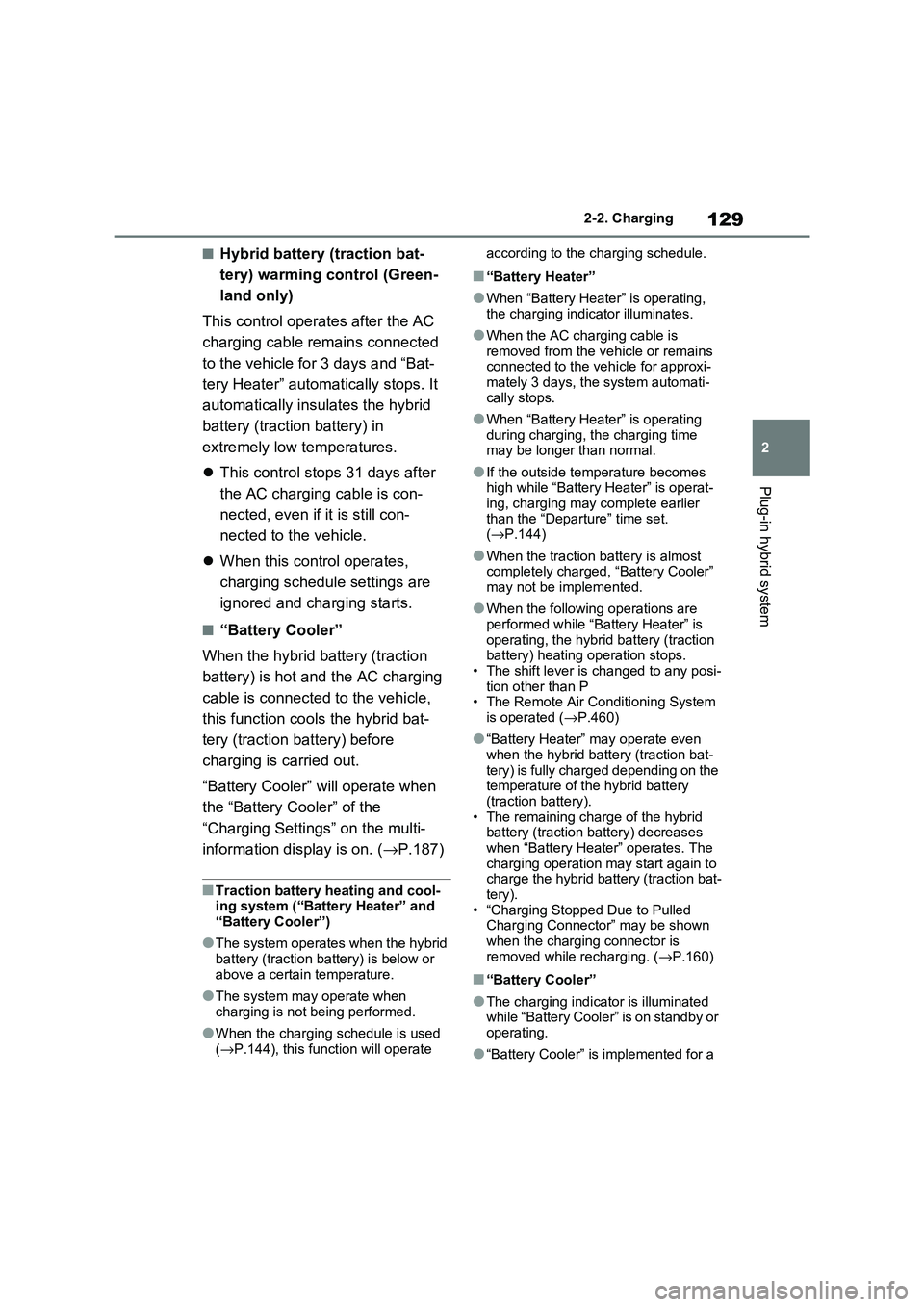
129
2
2-2. Charging
Plug-in hybrid system
■Hybrid battery (traction bat -
tery) warming control (Green -
land only)
This control operates after the AC
charging cable remains connected
to the vehicle for 3 days and “Bat -
tery Heater” autom atically stops. It
automatically insulates the hybrid
battery (traction battery) in
extremely low temperatures.
This control stops 31 days after
the AC charging cable is con -
nected, even if it is still con -
nected to the vehicle.
When this control operates,
charging schedule settings are
ignored and charging starts.
■“Battery Cooler”
When the hybrid battery (traction
battery) is hot and the AC charging
cable is connected to the vehicle,
this function cools the hybrid bat -
tery (traction battery) before
charging is carried out.
“Battery Cooler” will operate when
the “Battery Cooler” of the
“Charging Settings” on the multi-
information di splay is on. (→P.187)
■Traction battery heating and cool-
ing system (“Battery Heater” and “Battery Cooler”)
●The system operates when the hybrid battery (traction battery) is below or
above a certain temperature.
●The system may operate when
charging is not being performed.
●When the charging schedule is used
( →P.144), this function will operate
according to the charging schedule.
■“Battery Heater”
●When “Battery Heat er” is operating,
the charging indi cator illuminates.
●When the AC charging cable is
removed from the v ehicle or remains
connected to the ve hicle for approxi- mately 3 days, t he system automati-
cally stops.
●When “Battery Heat er” is operating
during charging, the charging time
may be longer than normal.
●If the outside temperature becomes
high while “Batter y Heater” is operat- ing, charging may complete earlier
than the “Departure” time set.
( →P.144)
●When the traction battery is almost
completely charged , “Battery Cooler” may not be implemented.
●When the following operations are performed while “Battery Heater” is
operating, the hybrid battery (traction
battery) heating operation stops. • The shift lever is changed to any posi-
tion other than P
• The Remote Air Conditioning System is operated ( →P.460)
●“Battery Heater” may operate even when the hybrid battery (traction bat -
tery) is fully charged depending on the
temperature of the hybrid battery (traction battery).
• The remaining charge of the hybrid
battery (traction battery) decreases when “Battery Heater” operates. The
charging operation may start again to
charge the hybrid battery (traction bat - tery).
• “Charging Stopped Due to Pulled
Charging Connector” may be shown
when the charging connector is removed while recharging. ( →P.160)
■“Battery Cooler”
●The charging indicator is illuminated while “Battery Cooler” is on standby or
operating.
●“Battery Cooler” is i mplemented for a
Page 132 of 666
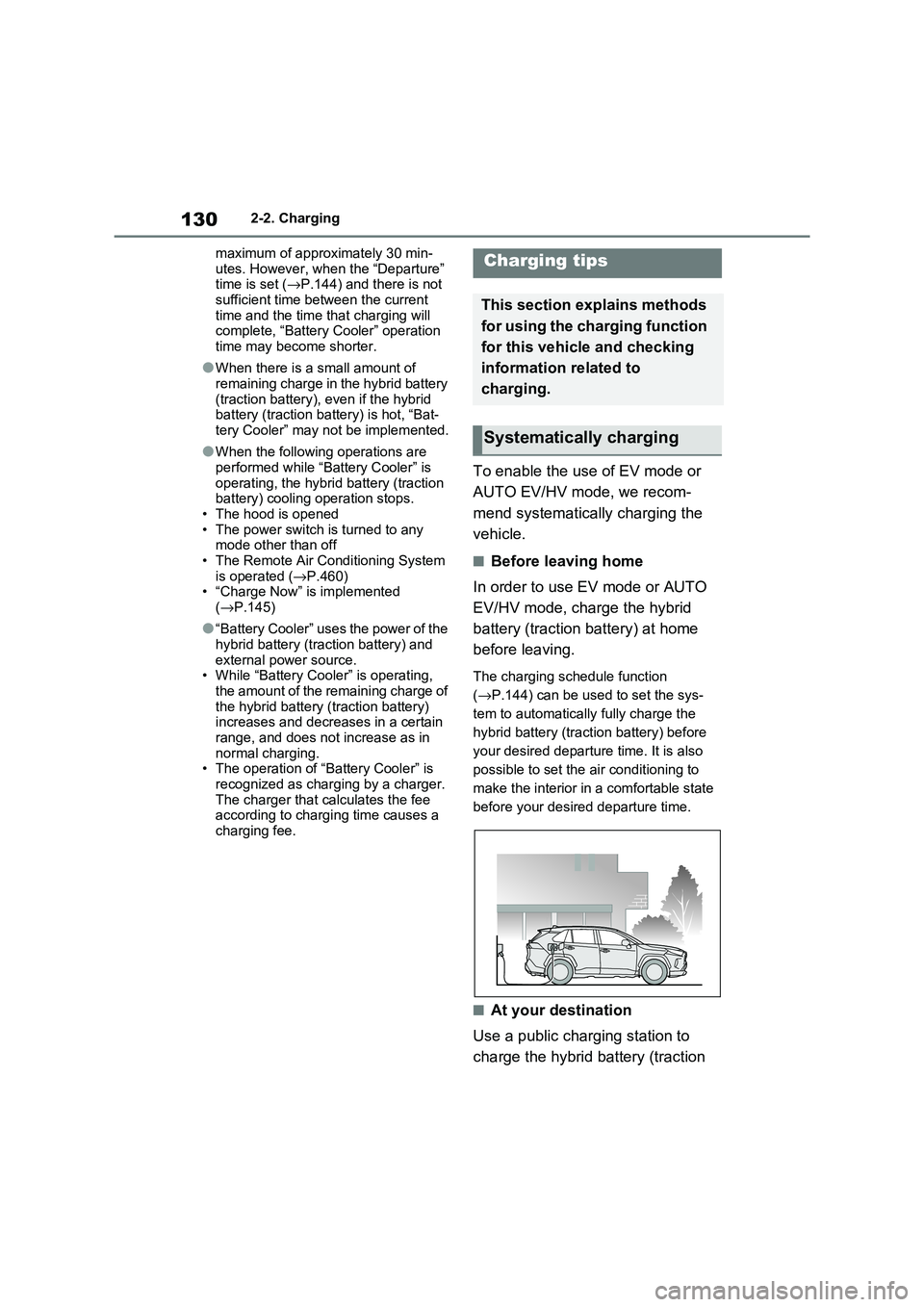
1302-2. Charging
maximum of approximately 30 min -
utes. However, when the “Departure” time is set ( →P.144) and there is not
sufficient time between the current
time and the time that charging will complete, “Battery Cooler” operation
time may become shorter.
●When there is a small amount of
remaining charge in the hybrid battery
(traction battery), even if the hybrid battery (traction battery) is hot, “Bat -
tery Cooler” may not be implemented.
●When the following operations are
performed while “Battery Cooler” is
operating, the hybrid battery (traction battery) cooling operation stops.
• The hood is opened
• The power switch is turned to any mode other than off
• The Remote Air Conditioning System
is operated ( →P.460) • “Charge Now” is implemented
( →P.145)
●“Battery Cooler” uses the power of the
hybrid battery (tr action battery) and
external power source. • While “Battery Cooler” is operating,
the amount of the remaining charge of
the hybrid battery (traction battery) increases and decreases in a certain
range, and does not increase as in
normal charging. • The operation of “Battery Cooler” is
recognized as charging by a charger.
The charger that calculates the fee according to charging time causes a
charging fee.
To enable the use of EV mode or
AUTO EV/HV mode, we recom -
mend systematically charging the
vehicle.
■Before leaving home
In order to use EV mode or AUTO
EV/HV mode, charge the hybrid
battery (traction battery) at home
before leaving.
The charging schedule function
( →P.144) can be used to set the sys-
tem to automatically fully charge the
hybrid battery (traction battery) before
your desired departu re time. It is also
possible to set the air conditioning to
make the interior in a comfortable state
before your desire d departure time.
■At your destination
Use a public charging station to
charge the hybrid battery (traction
Charging tips
This section explains methods
for using the charging function
for this vehicle and checking
information related to
charging.
Systematically charging
Page 133 of 666
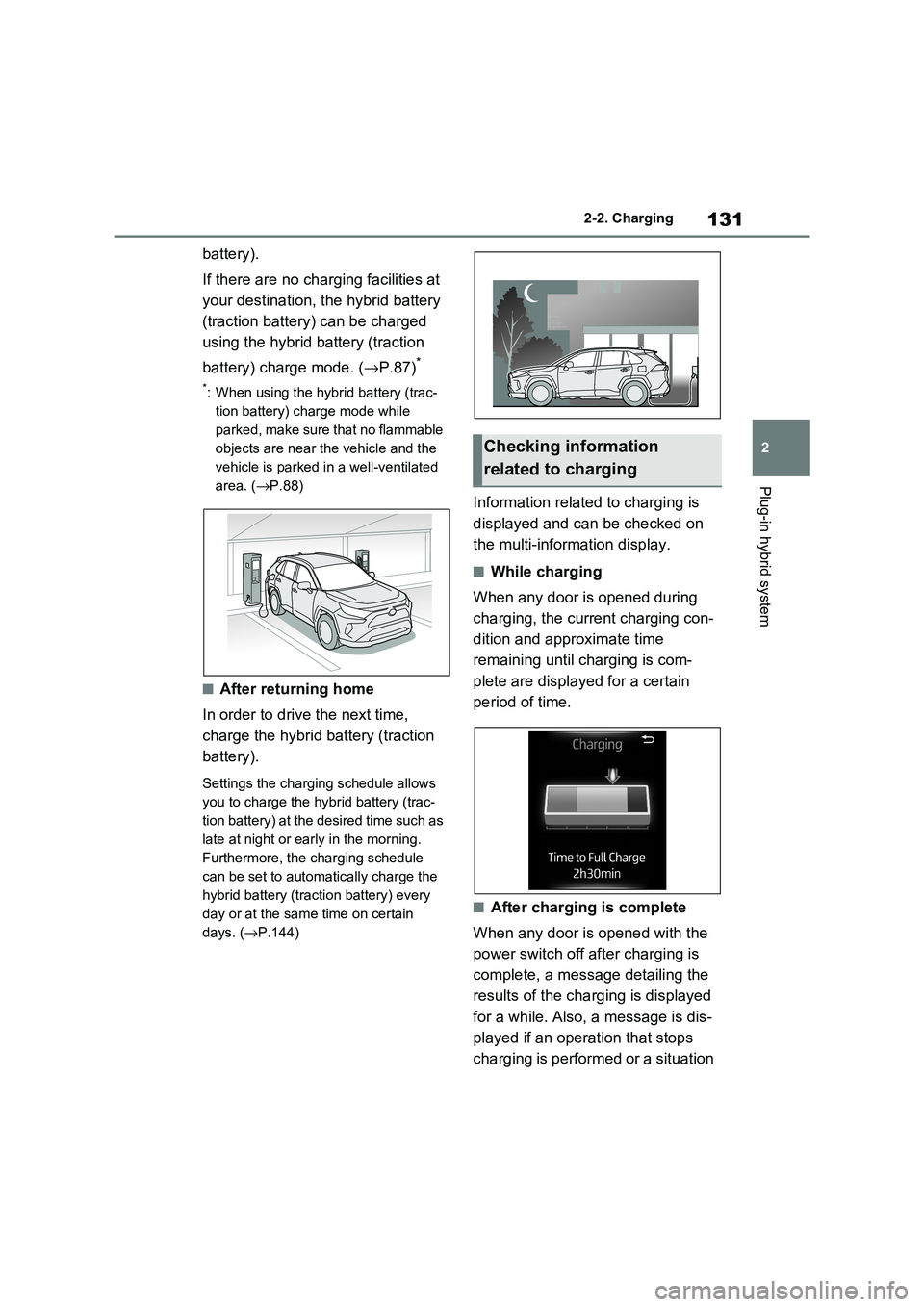
131
2
2-2. Charging
Plug-in hybrid system
battery).
If there are no char ging facilities at
your destination, t he hybrid battery
(traction battery) can be charged
using the hybrid battery (traction
battery) charge mode. ( →P.87)*
*: When using the hybrid battery (trac-
tion battery) charge mode while
parked, make sure that no flammable
objects are near t he vehicle and the
vehicle is parked in a well-ventilated
area. ( →P.88)
■After returning home
In order to drive the next time,
charge the hybrid battery (traction
battery).
Settings the charging schedule allows
you to charge the hy brid battery (trac-
tion battery) at the desired time such as
late at night or earl y in the morning.
Furthermore, the charging schedule
can be set to automat ically charge the
hybrid battery (traction battery) every
day or at the same time on certain
days. ( →P.144)
Information related to charging is
displayed and can be checked on
the multi-information display.
■While charging
When any door is opened during
charging, the current charging con -
dition and approximate time
remaining until charging is com -
plete are displayed for a certain
period of time.
■After charging is complete
When any door is opened with the
power switch off after charging is
complete, a message detailing the
results of the charging is displayed
for a while. Also, a message is dis -
played if an operation that stops
charging is performed or a situation
Checking information
related to charging
Page 134 of 666
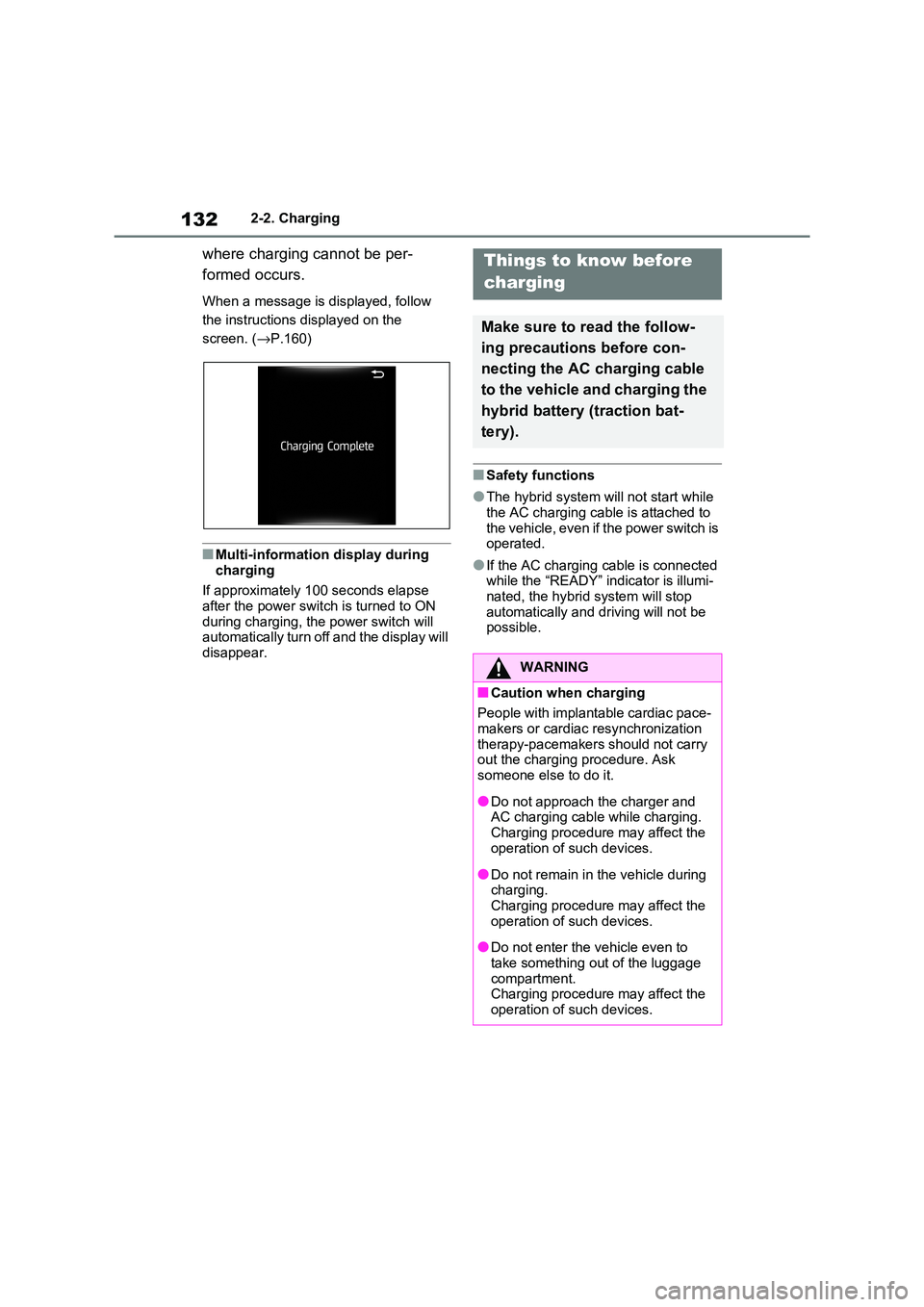
1322-2. Charging
where charging cannot be per-
formed occurs.
When a message is displayed, follow
the instructions displayed on the
screen. ( →P.160)
■Multi-information display during
charging
If approximately 100 seconds elapse
after the power switch is turned to ON
during charging, the power switch will automatically turn off and the display will
disappear.
■Safety functions
●The hybrid system wi ll not start while the AC charging cable is attached to
the vehicle, even if the power switch is
operated.
●If the AC charging cable is connected
while the “READY” indicator is illumi- nated, the hybrid system will stop
automatically and dr iving will not be
possible.
Things to know before
charging
Make sure to read the follow -
ing precautions before con -
necting the AC c harging cable
to the vehicle and charging the
hybrid battery (traction bat -
tery).
WARNING
■Caution when charging
People with implantable cardiac pace -
makers or cardiac resynchronization
therapy-pacemakers should not carry out the charging procedure. Ask
someone else to do it.
●Do not approach the charger and
AC charging cable while charging.
Charging procedure may affect the operation of such devices.
●Do not remain in the vehicle during charging.
Charging procedure may affect the
operation of such devices.
●Do not enter the vehicle even to
take something out of the luggage compartment.
Charging procedure may affect the
operation of such devices.
Page 135 of 666
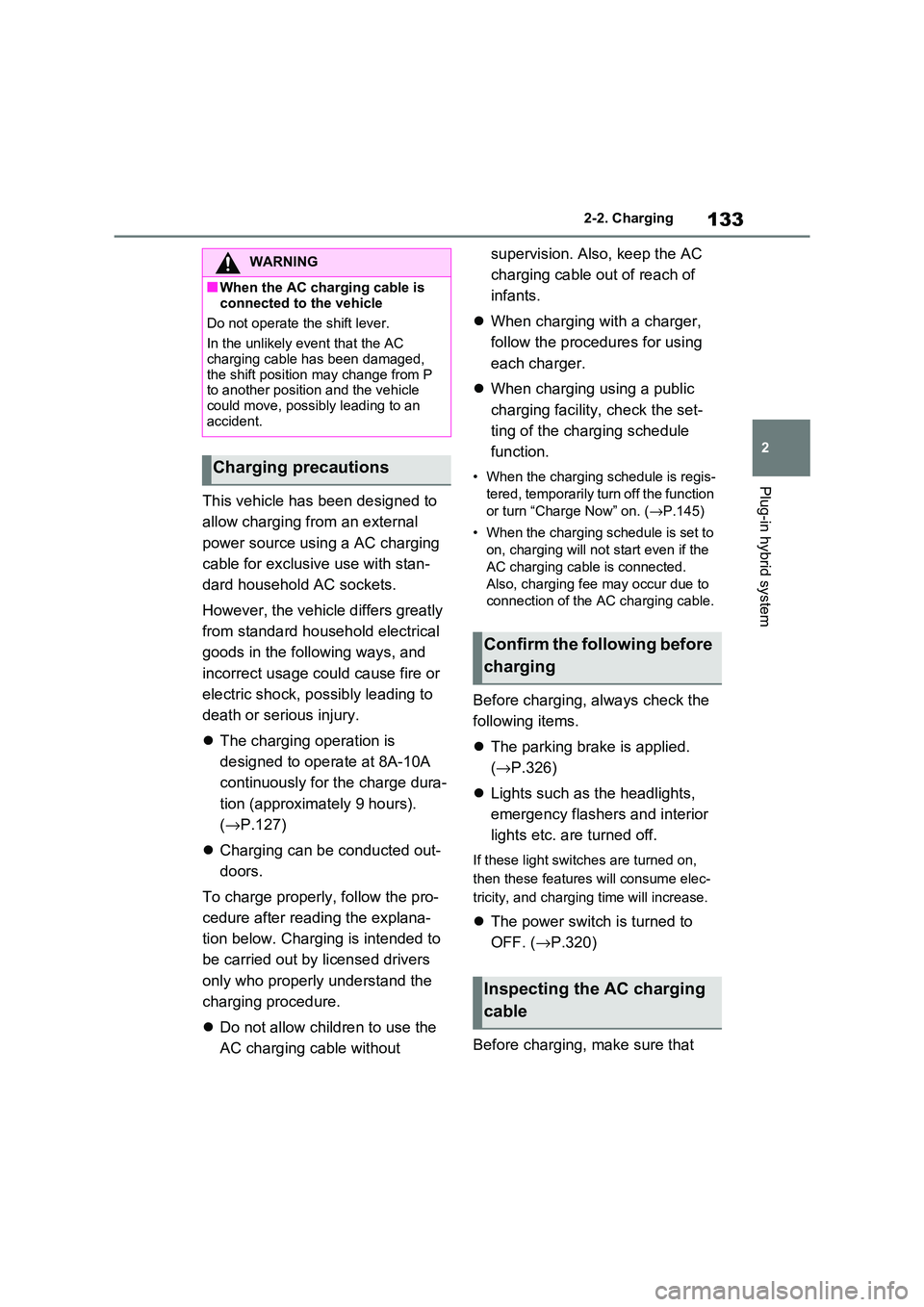
133
2
2-2. Charging
Plug-in hybrid system
This vehicle has been designed to
allow charging from an external
power source using a AC charging
cable for exclusive use with stan -
dard household AC sockets.
However, the vehicle differs greatly
from standard household electrical
goods in the following ways, and
incorrect usage could cause fire or
electric shock, possibly leading to
death or serious injury.
The charging operation is
designed to ope rate at 8A-10A
continuously for the charge dura -
tion (approximately 9 hours).
( →P.127)
Charging can be conducted out-
doors.
To charge properly, follow the pro -
cedure after reading the explana -
tion below. Charging is intended to
be carried out by licensed drivers
only who properly understand the
charging procedure.
Do not allow children to use the
AC charging cable without
supervision. Also, keep the AC
charging cable out of reach of
infants.
When charging with a charger,
follow the procedures for using
each charger.
When charging using a public
charging facility, check the set -
ting of the charging schedule
function.
• When the charging schedule is regis -
tered, temporarily turn off the function
or turn “Charge Now” on. ( →P.145)
• When the charging schedule is set to
on, charging will not start even if the
AC charging cable is connected.
Also, charging fee may occur due to
connection of the A C charging cable.
Before charging, always check the
following items.
The parking brake is applied.
( →P.326)
Lights such as the headlights,
emergency flashers and interior
lights etc. are turned off.
If these light switche s are turned on,
then these features will consume elec-
tricity, and charging time will increase.
The power switch is turned to
OFF. ( →P.320)
Before charging, make sure that
WARNING
■When the AC charging cable is
connected to the vehicle
Do not operate the shift lever.
In the unlikely event that the AC
charging cable ha s been damaged,
the shift position may change from P to another positio n and the vehicle
could move, possibly leading to an
accident.
Charging precautions
Confirm the following before
charging
Inspecting the AC charging
cable
Page 136 of 666
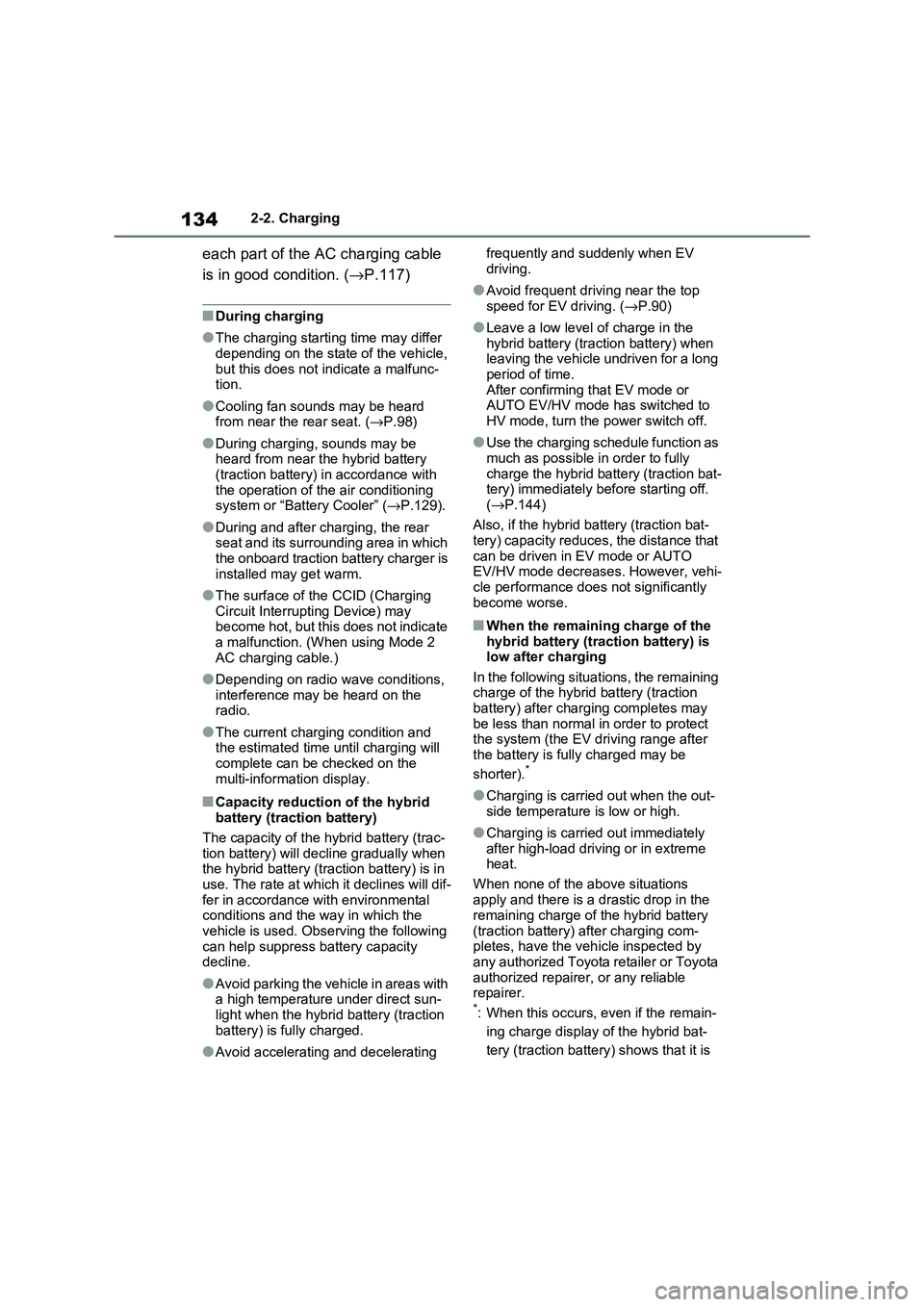
1342-2. Charging
each part of the AC charging cable
is in good condition. ( →P.117)
■During charging
●The charging starting time may differ
depending on the state of the vehicle,
but this does not indicate a malfunc - tion.
●Cooling fan sounds may be heard from near the rear seat. ( →P.98)
●During charging, sounds may be heard from near the hybrid battery
(traction battery) in accordance with
the operation of the air conditioning system or “Battery Cooler” ( →P.129).
●During and after charging, the rear seat and its surrounding area in which
the onboard traction battery charger is
installed may get warm.
●The surface of the CCID (Charging
Circuit Interrupting Device) may become hot, but this does not indicate
a malfunction. ( When using Mode 2
AC charging cable.)
●Depending on radio wave conditions,
interference may be heard on the radio.
●The current chargi ng condition and the estimated time until charging will
complete can be checked on the
multi-information display.
■Capacity reduction of the hybrid
battery (tracti on battery)
The capacity of the hybrid battery (trac -
tion battery) will dec line gradually when
the hybrid battery (tr action battery) is in use. The rate at which it declines will dif -
fer in accordance with environmental
conditions and the way in which the vehicle is used. Observing the following
can help suppress battery capacity
decline.
●Avoid parking the vehicle in areas with
a high temperature under direct sun - light when the hybrid battery (traction
battery) is fully charged.
●Avoid accelerating and decelerating
frequently and suddenly when EV
driving.
●Avoid frequent driving near the top
speed for EV driving. ( →P.90)
●Leave a low level of charge in the
hybrid battery (trac tion battery) when leaving the vehicle undriven for a long
period of time.
After confirming that EV mode or AUTO EV/HV mode has switched to
HV mode, turn the power switch off.
●Use the charging schedule function as
much as possible in order to fully
charge the hybrid battery (traction bat - tery) immediately bef ore starting off.
( →P.144)
Also, if the hybrid battery (traction bat- tery) capacity reduces, the distance that
can be driven in EV mode or AUTO
EV/HV mode decreases. However, vehi - cle performance does not significantly
become worse.
■When the remaining charge of the
hybrid battery (trac tion battery) is low after charging
In the following situations, the remaining
charge of the hybrid battery (traction battery) after charging completes may
be less than normal in order to protect
the system (the EV dr iving range after the battery is fully charged may be
shorter).*
●Charging is carried out when the out -
side temperature is low or high.
●Charging is carried out immediately
after high-load driv ing or in extreme
heat.
When none of the above situations
apply and there is a drastic drop in the
remaining charge of the hybrid battery
(traction battery) after charging com - pletes, have the veh icle inspected by
any authorized Toyota retailer or Toyota
authorized repairer, or any reliable repairer.*: When this occurs, even if the remain -
ing charge display of the hybrid bat-
tery (traction battery) shows that it is
Page 137 of 666
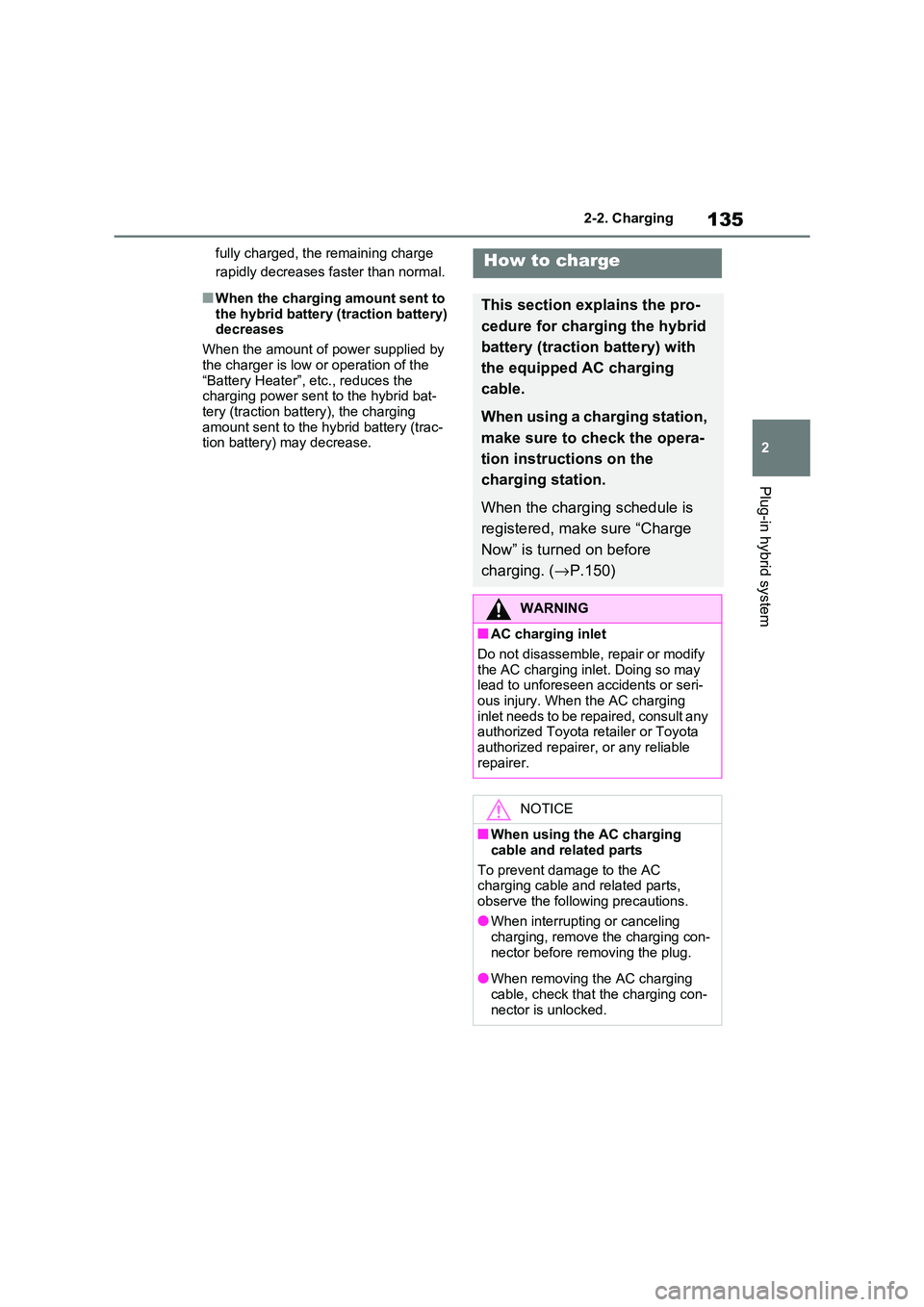
135
2
2-2. Charging
Plug-in hybrid system
fully charged, the remaining charge
rapidly decreases faster than normal.
■When the charging amount sent to
the hybrid battery (traction battery)
decreases
When the amount of power supplied by
the charger is low or operation of the
“Battery Heater”, etc., reduces the charging power sen t to the hybrid bat-
tery (traction battery), the charging
amount sent to the hy brid battery (trac- tion battery) may decrease.
How to charge
This section explains the pro -
cedure for charging the hybrid
battery (traction battery) with
the equipped AC charging
cable.
When using a charging station,
make sure to check the opera -
tion instructions on the
charging station.
When the charging schedule is
registered, make sure “Charge
Now” is turned on before
charging. ( →P.150)
WARNING
■AC charging inlet
Do not disassemble, repair or modify
the AC charging inlet. Doing so may lead to unforeseen accidents or seri -
ous injury. When the AC charging
inlet needs to be repaired, consult any authorized Toyota retailer or Toyota
authorized repairer, or any reliable
repairer.
NOTICE
■When using the AC charging
cable and related parts
To prevent damage to the AC charging cable and related parts,
observe the following precautions.
●When interrupting or canceling charging, remove the charging con -
nector before removing the plug.
●When removing the AC charging
cable, check that the charging con -
nector is unlocked.
Page 138 of 666
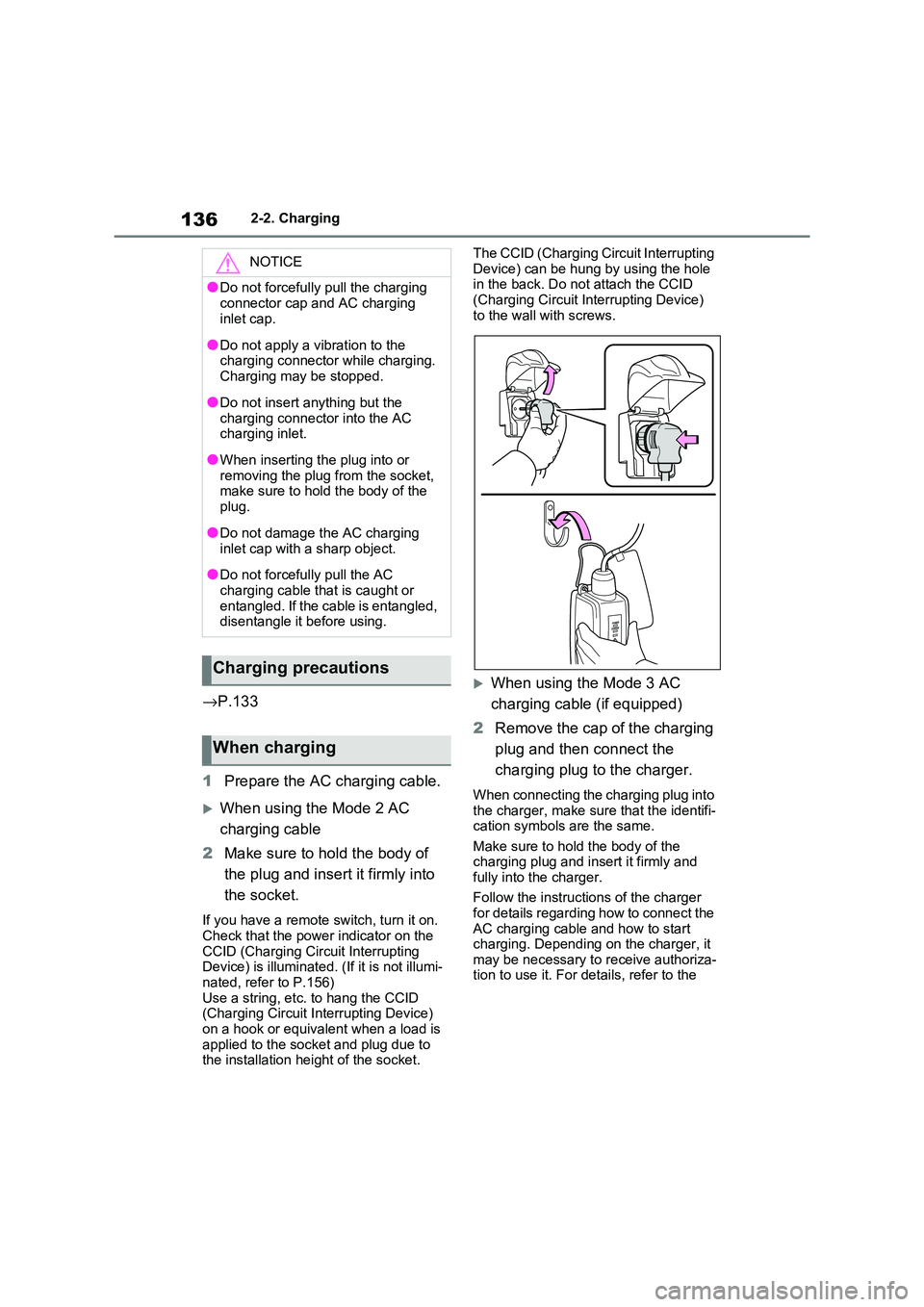
1362-2. Charging
→P.133
1 Prepare the AC charging cable.
When using the Mode 2 AC
charging cable
2 Make sure to hold the body of
the plug and insert it firmly into
the socket.
If you have a remote switch, turn it on.
Check that the power indicator on the
CCID (Charging Circuit Interrupting Device) is illuminated . (If it is not illumi-
nated, refer to P.156)
Use a string, etc. to hang the CCID (Charging Circuit Interrupting Device)
on a hook or equivalent when a load is
applied to the socket and plug due to the installation hei ght of the socket.
The CCID (Charging Circuit Interrupting
Device) can be hung by using the hole in the back. Do not attach the CCID
(Charging Circuit In terrupting Device)
to the wall with screws.
When using the Mode 3 AC
charging cable (if equipped)
2 Remove the cap of the charging
plug and then connect the
charging plug to the charger.
When connecting the charging plug into the charger, make su re that the identifi-
cation symbols are the same.
Make sure to hold the body of the charging plug and insert it firmly and
fully into the charger.
Follow the instructions of the charger for details regarding how to connect the
AC charging cable and how to start
charging. Depending on the charger, it may be necessary to receive authoriza-
tion to use it. For details, refer to the
NOTICE
●Do not forcefully pull the charging
connector cap and AC charging
inlet cap.
●Do not apply a vi bration to the
charging connector while charging. Charging may be stopped.
●Do not insert anything but the
charging connector into the AC charging inlet.
●When inserting the plug into or removing the plug from the socket,
make sure to hold the body of the
plug.
●Do not damage t he AC charging
inlet cap with a sharp object.
●Do not forcefully pull the AC
charging cable that is caught or entangled. If the cable is entangled,
disentangle i t before using.
Charging precautions
When charging
Page 139 of 666
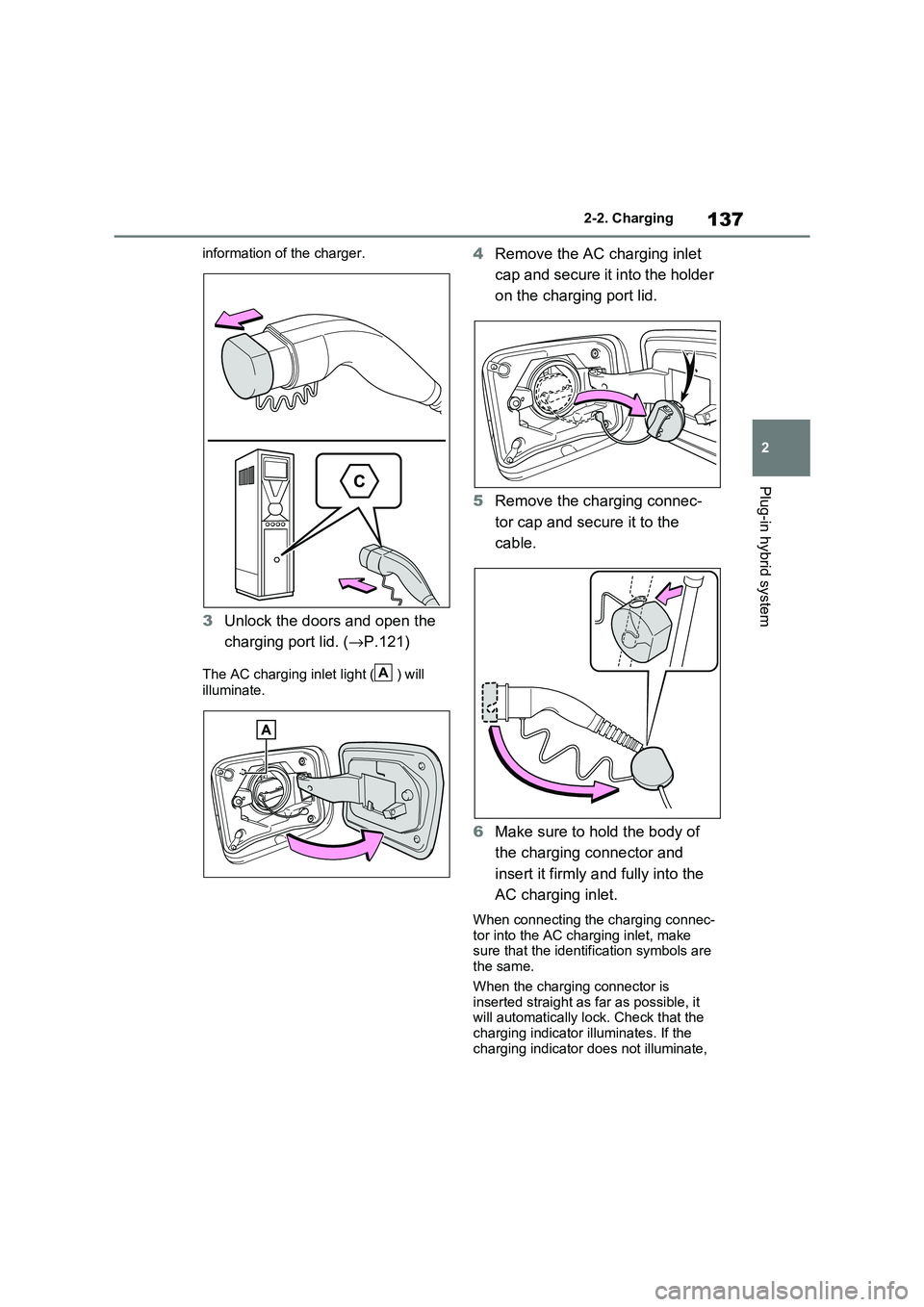
137
2
2-2. Charging
Plug-in hybrid system
information of the charger.
3 Unlock the doors and open the
charging port lid. ( →P.121)
The AC charging inlet light ( ) will
illuminate.
4 Remove the AC charging inlet
cap and secure it into the holder
on the charging port lid.
5 Remove the charging connec-
tor cap and secure it to the
cable.
6 Make sure to hold the body of
the charging connector and
insert it firmly and fully into the
AC charging inlet.
When connecting the charging connec -
tor into the AC char ging inlet, make sure that the identifi cation symbols are
the same.
When the charging connector is inserted straight as far as possible, it
will automatically lock. Check that the
charging indicator illuminates. If the charging indicator does not illuminate,
A
Page 140 of 666
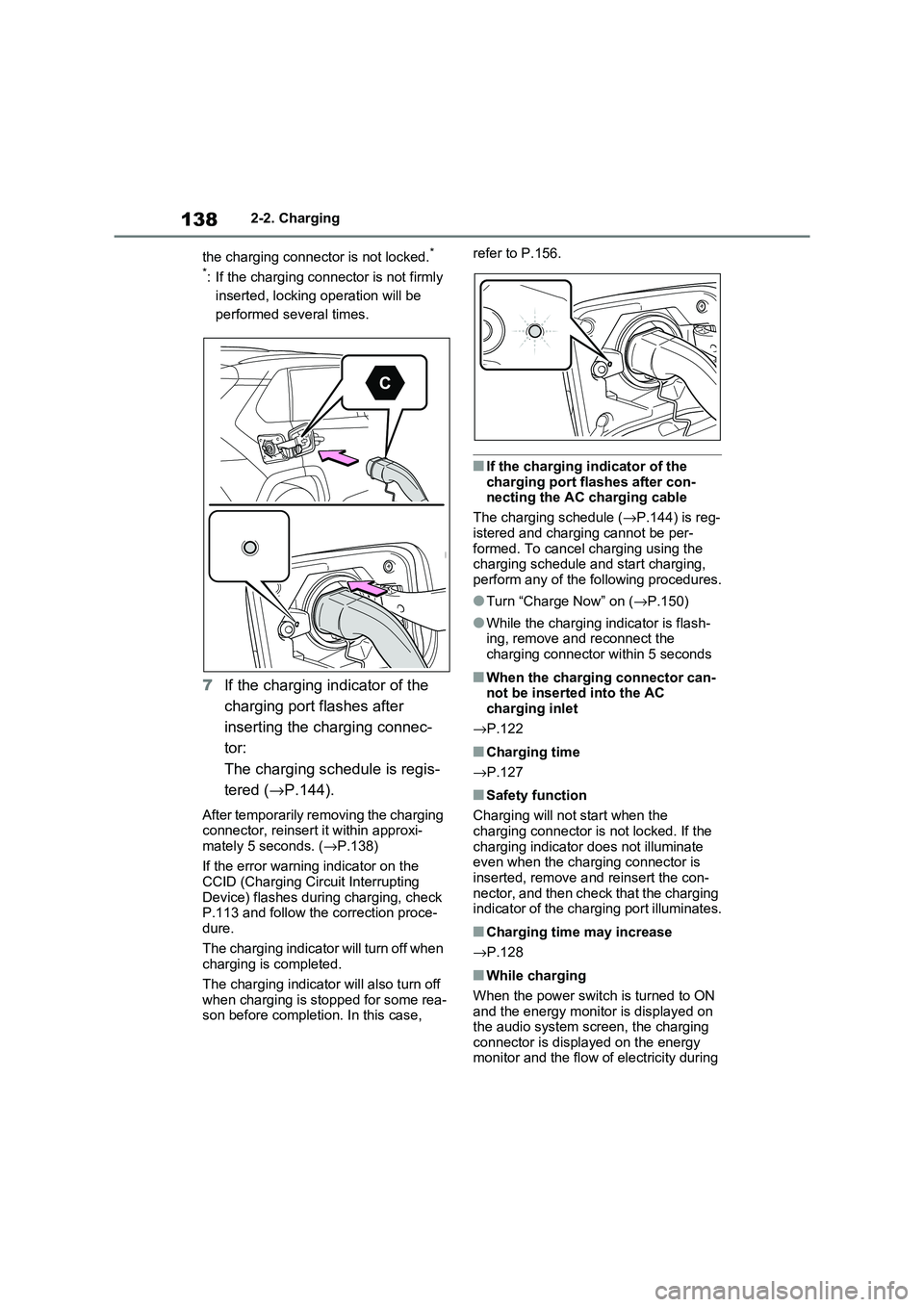
1382-2. Charging
the charging connector is not locked.*
*: If the charging connector is not firmly
inserted, locking operation will be
performed se veral times.
7If the charging indicator of the
charging port flashes after
inserting the charging connec -
tor:
The charging schedule is regis -
tered ( →P.144).
After temporarily removing the charging connector, reinsert it within approxi -
mately 5 seconds. ( →P.138)
If the error warning indicator on the CCID (Charging Circuit Interrupting
Device) flashes during charging, check
P.113 and follow the correction proce - dure.
The charging indicator will turn off when
charging is completed.
The charging indicator will also turn off
when charging is stopped for some rea -
son before completi on. In this case,
refer to P.156.
■If the charging indicator of the
charging port flashes after con - necting the AC charging cable
The charging schedule ( →P.144) is reg-
istered and charging cannot be per - formed. To cancel charging using the
charging schedule and start charging,
perform any of the following procedures.
●Turn “Charge Now” on ( →P.150)
●While the charging indicator is flash-
ing, remove and reconnect the
charging connector within 5 seconds
■When the charging connector can - not be inserted into the AC
charging inlet
→ P.122
■Charging time
→ P.127
■Safety function
Charging will not start when the
charging connector is not locked. If the charging indicator does not illuminate
even when the charging connector is
inserted, remove a nd reinsert the con- nector, and then check that the charging
indicator of the charging port illuminates.
■Charging time may increase
→ P.128
■While charging
When the power switch is turned to ON and the energy monitor is displayed on
the audio system scr een, the charging
connector is displayed on the energy monitor and the flow of electricity during